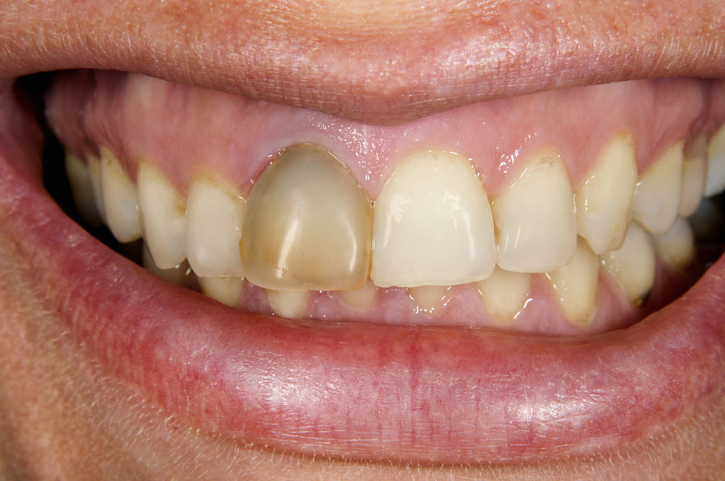
Everyone knows that anything from smoking to poor oral hygiene can result in yellow teeth. As such, having a blue or gray tooth can be scary. Here’s what you need to know.
You probably know that everything from smoking to poor oral hygiene can result in yellow stains on your teeth. But what’s up with blue or gray teeth? Yes, there’s a chance that the teeth might have died, but that isn’t the only possible explanation. Sometimes tooth discoloration is natural and simply a cosmetic problem, but it may also signify dental trauma or another oral health problem.
Let’s talk about the causes of blue or gray teeth and what you can do to get a bright, white smile.
Causes Of Blue Or Gray Teeth
Aging
Aging brings a lot of changes, including dental ones. As you get older, your enamel will wear down, allowing the yellow dentin underneath to show. However, your teeth may also turn a grayish-blue color as you age.
Dead Teeth
There’s always the chance that your tooth is turning blue or gray because it’s dead. A healthy tooth consists of nerves and living pulp. If you notice a tooth or two turning gray, blue, black, or dark pink, the nerves and pulp within the tooth may have died. Infection, trauma, and decay can cause teeth to die and turn a different color.
Dentinogenesis Imperfecta
If you have dentinogenesis imperfecta (hereditary opalescent dentin), your teeth may become translucent or take on a yellow-brown or blue-gray appearance. This rare genetic condition can also result in misaligned and weakened teeth, leading to wear, breakage, and tooth loss.
Dental Restorations
Dental restoration procedures can help correct many dental problems, including chips, cracks, discoloration, decay, and missing teeth. Unfortunately, they can also cause discoloration. Over time, the materials used to restore your teeth and fill your cavities (like dental amalgam, acrylic, glass ionomer, and porcelain) may look blue or gray when showing through your teeth’s translucent enamel or a porcelain surface.
Dental Trauma
After an injury to your tooth, gums, or any nearby tissue, your tooth might not receive a sufficient amount of blood and turn blue or gray. Sometimes, your tooth might heal itself and return to its original color, but other times, it may stay discolored or die.
Exposure To Antibiotics As A Fetus Or Child
Being exposed to tetracycline before the age of eight can result in teeth discoloration — often in the form of blue-gray or yellow-brown horizontal stripes — later in life. Unfortunately, stains resulting from early antibiotic exposure won’t go away on their own, no matter how much you brush and floss.
Root Canals
You might experience tooth discoloration if any pulp tissue or material used to fill the canals was left inside your tooth during a root canal. Root canal medications like Ledermix (whose active ingredients include demeclocycline hydrochloride and triamcinolone acetonide) and Ultracal XS (which contains calcium hydroxide) can also cause tooth discoloration.
To determine the cause behind a gray or blue tooth, your dentist will carefully examine your teeth and gums. They may also order an x-ray to get a better view or perform a pulp test to spot any signs of pulp necrosis.
What Are Some Treatment Options For Blue Or Gray Teeth?
If you have a blue or gray tooth and don’t like the way it looks, don’t worry! There are plenty of safe professional treatment options, such as:
- Whitening Treatments: Whitening treatments are known for working on yellowed teeth, but they can also improve the color of blue or gray teeth, whether they are naturally that color or have died. You can use at-home bleaching solutions, laser teeth whitening treatments, or whitening gels, strips, and toothpastes to improve your teeth’s appearance. However, if your teeth are discolored due to being exposed to tetracycline at a young age, your teeth may bleach unevenly.
- Veneers: In addition to improving the appearance of chipped, cracked, or misaligned teeth, dental veneers can hide any blue or gray teeth. These semi-permanent, custom-made covers are thin and will fit seamlessly onto your front teeth. Not only can you pick your veneer’s specific shade of white, but you can also choose from different types of veneers, like porcelain veneers and Lumineers.
- Crowns: You can also opt for dental crowns. These tooth-shaped caps can be placed over discolored or damaged teeth, improving their appearance and restoring their shape, size, and strength. Common materials for crowns include porcelain, stainless steel, resin, and ceramic.
Need Professional Help?
If you’ve noticed any teeth discoloration, see a dentist as soon as possible. Not only will they be able to tell if the discoloration is due to trauma, pulp necrosis, or something else, but they can determine the best method for improving your tooth’s appearance.
If you live near Oklahoma City, you can visit Espire’s Norman, Oklahoma office. Our experienced dentists will be able to diagnose the cause of your tooth discoloration and can help you determine which treatment method will be most effective. Contact us today!
